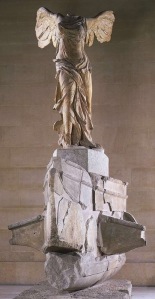Raphael was “gentle” and “humane,” says Giorgio Vasari in Lives of the Artists. (Which was published in 1550 – Vasari had seen vast changes in art within his own lifetime, and thought somebody ought to write this down.) Full of “natural modesty and goodness and good-fellowship,” he avoided “savagery” in life and in his work. His figures, like St. Michael in the painting at left, possess “grandeur and majesty.”
Prof. Richard Brettell describes this St. Michael as serene and calm, even though he’s in the act of fighting Satan. Here, we see Raphael’s idealism and optimism about humanity. Raphael conveys a kind of hopefulness, that we can understand the universe and ourselves.
One of my favorite quotes is from Milton: “The mind is its own place, and in itself can make a heaven of hell, a hell of heaven.” Raphael prefers to make a heaven. His St. Michael, in vanquishing Satan, pushes aside the dark, devilish corners of the human mind, the shadows, the evil. Raphael’s ideal: the good, achieving, creating mind can conquer the bad parts of human experience.
As a 21st-century writer, I tend to think like Raphael. Yes, I know of war, genocide, famine, disease, cruelty, stupidity, ignorance, environmental destruction. And yet I create visions of the world in which humans are almost gods: creating marvelous technology, accessing all the knowledge of the past, using modern science to understand the universe like never before. It’s not that I ignore the presence of evil. Rather, I choose, like Raphael, to imagine how we might overcome it.
Raphael lacks the dark, lurking danger of Leonardo (more on this here). I’m not saying that Raphael is better, or worse, than Leonardo – simply that they represent different styles of creation. Maybe we, as creators, could have both options in our “tool kits.” Sometimes, we might need a dark, pessimistic picture of humanity and the 21st century. At other times, we might need a positive statement of human potential. Or a mix of both.
What do you think? Do you tend to share Raphael’s optimism, or do you prefer a different view of the world? If you’re an artist/writer/musician, are your creations idealistic, pessimistic, or something in between?






